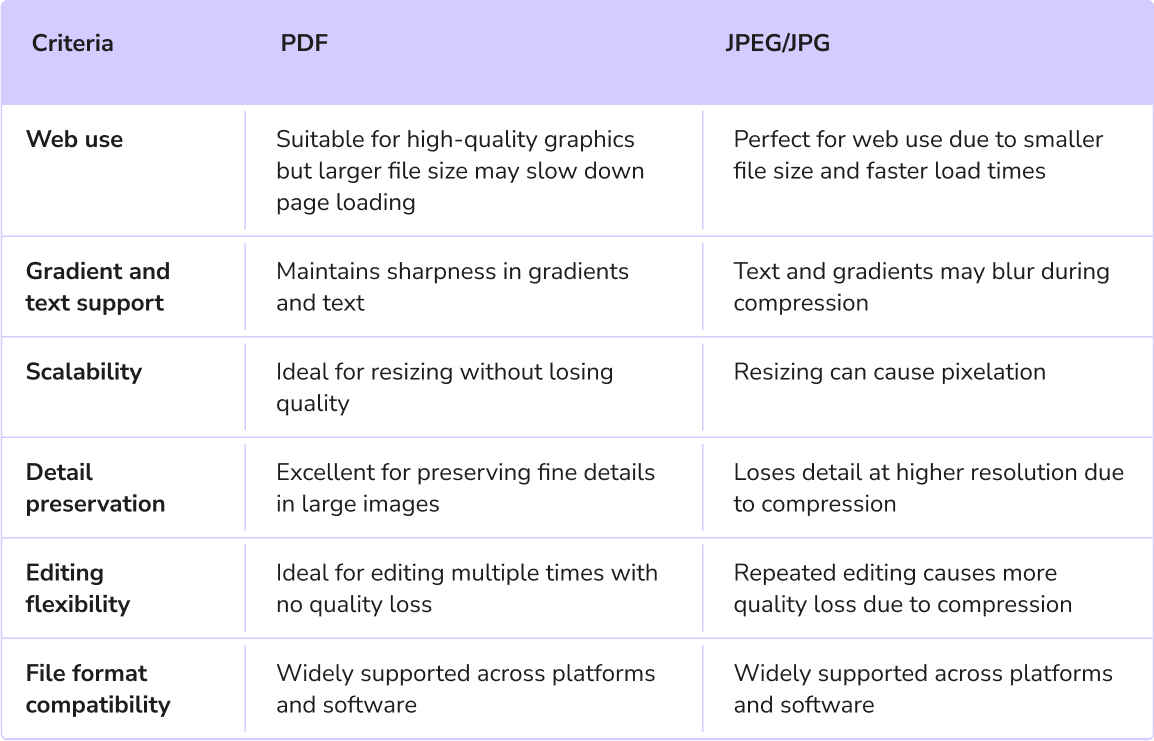When working with digital images, picking the right file format is more important than you think. It can affect both the quality and size of your images. JPEG and PNG are two of the most popular formats, each offering unique advantages. By understanding their key differences, you can make confident choices that help your projects come out just as you imagined.
In this guide, we’ll break down everything you need to know — from which format offers higher quality, JPEG or PNG, to how you can easily convert between them.
What's the difference between PNG and JPG?
Before we dive into the differences between PNG and JPEG files, let’s talk about their purpose. To clarify, JPEG and JPG refer to the same format, with the only difference being the file extension. JPG is simply a shortened version used due to older limitations in file naming.
Knowing how the JPG and PNG formats work will help you understand why one may be better for certain tasks.
Definition and usage
PNG, which stands for Portable Network Graphics, is a high-quality image format that supports transparency and is great for detailed graphics like logos or digital art. It keeps all image details intact without losing quality.
JPEG is an image format created by the Joint Photographic Experts Group, and its name stands for the same. It is a compressed image format often used for photos. It reduces file size but sacrifices some image quality, making it ideal for web use and faster loading times.
PNG vs. JPG: Key features and use cases

What is the higher quality format: JPEG or PNG?
PNG is the higher-quality format because it keeps all the details and doesn't lose anything when saved. This makes it perfect for things like logos, graphics, or images that need a clear background.
JPEG compresses the image to reduce file size, which sacrifices some quality. It’s great for regular photos where perfect detail isn’t as crucial, and file size matters more. So, if you want the best image quality, choose PNG. But for everyday photos and faster loading, JPEG format is usually the better option.
Whatever format you start with, PDF Guru makes it easy to convert JPG or PNG in just a few clicks. The process is quick, secure, and ensures your image quality remains intact.
Is JPEG or PNG better for printing?
PNG is often the better choice compared to JPEG image file type for a few reasons. First, PNG uses lossless compression, which means it keeps all the original image details, making it perfect for high-resolution prints. On the other hand, JPEG compresses the image by losing some details, making prints look a bit blurry or less sharp.
PNG also handles colors better, supporting a wider range of shades and deeper color depth. Plus, PNG files support transparent backgrounds, so you can overlay images without that annoying white box around them — a feature JPEG doesn’t offer.
Do JPEG and PNG support transparency?
JPEG doesn’t allow for transparency, so if an image has a see-through part, it will be replaced with a solid color, usually white. This makes JPEG less useful for images that need to blend smoothly with different backgrounds. Conversely, PNG supports transparency, which means you can have images with clear backgrounds — no visible box around them.
Is JPG smaller than PNG?
Yes, JPG files are usually smaller than PNG. This is because JPG compresses the image by removing some details, which makes the file size smaller but can cause some loss in quality as a result. PNG, however, keeps all the details, so the file is larger.
How to convert JPG to PNG or PNG to JPG
Do you have a file that you need to save as PNG or JPEG? We can help you with that.
Use our online converter and get what you need in a few clicks.
- 1
- Log into your account, choose Convert from the upper menu, and navigate to the PNG to JPG or the JPG to PNG tool.
- 2
- Upload your original file or simply drag and drop it into the designated area.
- 3
- Wait a few seconds for the converter to complete the process.
- 4
- The converted image will be automatically downloaded to your device and saved in your PDF Guru account.
Bottom line: When to use each image format
PNG or JPG for web? It depends on factors like image size, quality, and whether you need transparency, especially when considering how many pixels are in the image. Experiment with both formats to see which one best suits your specific task.
PNG or JPEG for printing? Use PNG images when you need high-quality images with sharp details and transparency, such as logos or graphics. Opt for JPEG when printing photographs where slight quality loss is acceptable and smaller file sizes are beneficial.
PNG or JPEG for quality results? For the best image quality without any loss, especially with detailed graphics or transparency, choose PNG. If a smaller file size is more important and minor quality loss is acceptable, JPEG is a suitable option.
We hope this guide has helped you make the right choice for your images and get your creative flow going. If you’re new to image formats, try experimenting with both to see the differences for yourself. And if you’re a pro, use our tool to quickly convert between formats and get exactly the file type you need.
